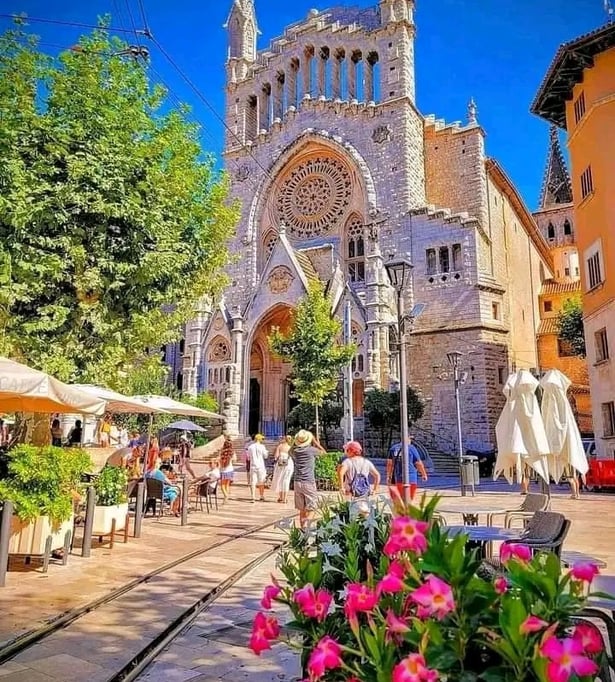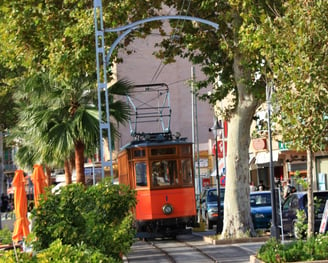Sóller : The French Connection
3 min read


The French Influence
Sóller and its Deep-Rooted French Connection: A Historical Tapestry
In the heart of Mallorca, surrounded by the majestic Tramuntana mountains, lies the village of Sóller, a place that has been intricately woven into the fabric of French history, culture, and commerce. This connection, spanning centuries, has not only shaped the village's identity but has also left an indelible mark on its landscape, architecture, and people.
The Dawn of the Connection: Early Settlers and Civilizations
The story of Sóller's French ties begins with Mallorca's first settlers. These pioneers, who ventured to the island from the South of France between the 6th and 5th centuries B.C., initially found solace in the island's caves. Over time, the island became a melting pot of cultures and civilizations. The Romans, arriving around 123 B.C., introduced the cultivation of wheat, vines, and the pioneering olive trees. These trees found a home in the sun-kissed island, particularly in the fertile valley of Sóller, which was strategically surrounded by towering mountains and had direct access to the azure waters of the Mediterranean Sea.
The Moors, who took over in 903, further enriched the island's agricultural landscape. They expanded the Roman-initiated irrigation systems, established vast olive plantations, and extracted the golden oil that the island is now renowned for. The Moors also introduced decorative orange trees, which not only added to the island's aesthetic appeal but also had medicinal properties. It's believed that the Moors named the town "Sóller", derived from terms that mean "golden valley" or "shell", perfectly encapsulating the town's geographical and agricultural richness.
The Renaissance of the French Influence
The pivotal moment in the island's history came with the conquest by King Jaume I of Aragón in 1229. With this conquest, the French connection was reinvigorated. The king, after driving out most of the Moors, divided the island amongst his vassals from the South of France and Catalonia. This redistribution led to the widespread adoption of the Catalan language, which bore a striking resemblance to medieval French. This linguistic connection further solidified the bond between Sóller and France.
However, the most profound French influence emerged during the tumultuous period of the French Revolution in 1789. As France was engulfed in chaos, many of its citizens, cutting across social strata, sought refuge in foreign lands. Sóller, with its welcoming climate and promising opportunities, became a haven for many French farmers, traders, and craftsmen. These refugees introduced the cultivation of sweet oranges, a crop that would redefine Sóller's agricultural landscape. The oranges, sourced from Southeast Asia, soon became a symbol of prosperity. The port of Sóller buzzed with activity as oranges were shipped to French towns, establishing a thriving trade network.
Challenges, Resilience, and Modern-Day Ties
However, prosperity is often punctuated by challenges. The 19th century saw a devastating pest infestation that decimated the flourishing orange plantations. This catastrophe plunged many Sollerics into poverty, pushing them to seek opportunities in France and even distant lands like the Caribbean. But adversity often breeds resilience. Many of these emigrants returned, bringing with them a plethora of influences. The architectural landscape of Sóller underwent a transformation, with colonial neo-baroque town palaces and Art Nouveau designs dotting its streets.
Today, Sóller's French connection is more vibrant than ever. The village continues to be a magnet for French tourists and expatriates. Institutions like the French school and the Alliance Francaise stand as testaments to the enduring ties. The maritime museum in Port de Sóller chronicles the village's rich trading history, and the legacy of figures like George Sand is celebrated and cherished.
In essence, Sóller is not just a village in Mallorca; it's a living tapestry of history, culture, and commerce that beautifully intertwines the destinies of two distinct regions. Its French connection is not just a chapter in history books but a palpable presence that resonates in its streets, homes, and the hearts of its people.




